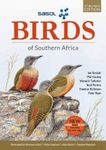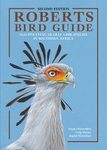Field / Identification Guide
By: Warwick Tarboton(Author)
419 pages, 2500 colour photos, colour illustrations
![Roberts Nests and Eggs of Southern African Birds Roberts Nests and Eggs of Southern African Birds]()
Click to have a closer look
About this book
Customer reviews
Biography
Related titles
About this book
This new field guide deals with the nesting habits of the 730 bird species known to breed in southern Africa. It is set out in a standard field-guide format (text pages facing colour plates), covering 4-5 species per double-page spread. The information given is an up-to-date summary of what is known about the nesting habits of each species: where they nest, when they nest, what the nest looks like, how many eggs they lay, how long these take to hatch, etc.
Approximately 1300 colour photographs, taken by 68 different photographers, illustrate most of the nests and birds, many reproduced here for the first time. Also included are 1200 photographic images of the eggs of each species, accurately coloured and all reproduced at life size, ranging from the large eggs of the vultures and eagles to the tiny eggs of waxbills and cisticolas.
Roberts Nests and Eggs of Southern African Birds is comprehensively cross-referenced and if one wanted to know, for example, about the nesting habits of a hoopoe, the book provides a comprehensive summary of the information known about the species, a couple of photographs of the birds at different nests to show the situations they use, and a range of illustrations of their eggs to show what these look like.
Although Roberts Nests and Eggs of Southern African Birds is technical in content, it is easy to use and will provide an essential resource to a broad spectrum of people with an interest in birds, as well as having an appeal to nature-lovers in general.
Customer Reviews
Biography
Warwick Tarboton is an authority on the nesting habits of birds and has published previously on the subject. He is also a well-known author and co-author of numerous other books on the birds of southern Africa, including one of the region's top-selling bird field guides.
Field / Identification Guide
By: Warwick Tarboton(Author)
419 pages, 2500 colour photos, colour illustrations
"[...] This is an excellent book, and is thoroughly recommended to anyone with even the slightest interest in nesting birds. My only cridcism is that its scope might have been extended to include brief descriptions of nestlings. There are many nestlings in Africa yet to be described, and small text additions would have helped to identify the gaps in our knowledge."
- Peter Castell, Bulletin of the African Bird Club 20(1), March 2013





































